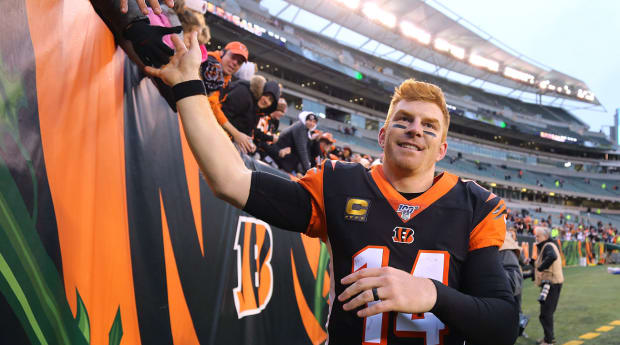Many fans will remember Andy Dalton's time in Cincinnati for what he didn't accomplish, but he was a fascinating player in an era when teams move on from quarterbacks faster than ever.
Andy Dalton and the Bengals
split up on Thursday in the kind of unceremonious breakup reserved for long-term quarterbacks of non-dynasties; the fan base barely torn between a sense of excitement about the future and lingering sense of loyalty and comfort from the last decade of service.Entering his age 33 season, Dalton will land somewhere soon and, depending on the location, get a chance to start a significant stretch of games again. Ryan Tannehill’s 2019 taught us not to completely shape a quarterback’s legacy before he’s had time to operate in a different system, surrounded by more complementary personnel. The hope is that Dalton finds a similar refuge, if only to battle back against the perception that he was basically the line at which to demarcate a good quarterback from a bad one, a position first adopted by my old friends on the Around The NFL podcast and their “Dalton Scale.”

Dalton was a fascinating player over his nine seasons with the Bengals—more so than we give him credit for. In an era where quarterbacks were discarded faster than ever, illogically blamed for their team’s successes and failures as if they curated the roster and designed the offense, he remained under center for nearly a decade despite the team never winning a playoff game. Part of that is thanks to the Bengals’ milieu; a team that has perpetually plodded along with the fiscal mentality of a White Elephant shopper. But part of that was Dalton, a player who, despite the team’s lack of playoff successes, seemed to engrain himself with the city and keep the Bengals somewhat relevant during the leaner years.
His foundation helped cover medical bills and better the lives of sick children. As the team’s reporter, Marisa Contipelli, noted on Twitter this week, he was the kind of person who would give up his first class seat to an injured player who didn’t want to fly home boxed in economy class.
And really, what more could we have expected from a second-round pick, the fifth quarterback drafted in the class of 2011? In hindsight, it seems as if we treated Dalton like the kind of quarterback who was never giving us everything we wanted, when in reality, he may have been giving his franchise more than they should have reasonably expected.
He had some very good seasons—in 2015 he was second in Football Outsiders’ Defense-Adjusted Value Over Average and third in ESPN’s total quarterback rating, both of which take various situational occurrences into account. That’s the season the Bengals started 8-0 and 10-2, before an injury ended Dalton’s season early in Week 14. He made three Pro Bowl appearances, though his DVOA and Total QBR both hovered in the late teens for the remainder of his time with the Bengals. He did so with his best complementary non-A.J. Green skill position players being Marvin Jones, Mohammed Sanu and Tyler Eifert.
All of this to say, we tend to emotionally discard players like this, writing off the space between Carson Palmer and Joe Burrow as some kind of prelude to an era of greatness. There’s no guarantee that the Bengals have found someone who can better navigate the challenges of playing in Cincinnati, just like there is no guarantee that we’ve seen the last of Dalton yet.
• Question or comment? Email us.

Post a Comment
Thanks For Comment We Will Get You Back Soon.